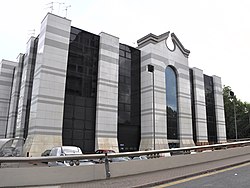
British Satellite Broadcasting plc (BSB) was a television company, based in London, that provided direct broadcast satellite television services to the United Kingdom. It started broadcasting on 25 March 1990. The company was merged with Sky Television plc on 2 November 1990 to form British Sky Broadcasting.

Birmingham Central Library was the main public library in Birmingham, England, from 1974 until 2013, replacing a library opened in 1865 and rebuilt in 1882. For a time the largest non-national library in Europe, it closed on 29 June 2013 and was replaced by the Library of Birmingham. The building was demolished in 2016, after 41 years, as part of the redevelopment of Paradise Circus by Argent Group. Designed by architect John Madin in the brutalist style, the library was part of an ambitious development project by Birmingham City Council to create a civic centre on its new Inner Ring Road system; however, for economic reasons significant parts of the master plan were not completed, and quality was reduced on materials as an economic measure. Two previous libraries occupied the adjacent site before Madin's library opened in 1974. The previous library, designed by John Henry Chamberlain, opened in 1883 and featured a tall clerestoried reading room. It was demolished in 1974 after the new library had opened.
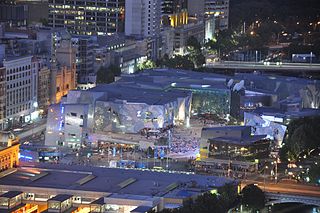
Federation Square is a venue for arts, culture and public events on the edge of the Melbourne central business district. It covers an area of 3.2 ha at the intersection of Flinders and Swanston Streets built above busy railway lines and across the road from Flinders Street station. It incorporates major cultural institutions such as the Ian Potter Centre, Australian Centre for the Moving Image (ACMI) and the Koorie Heritage Trust as well as cafes and bars in a series of buildings centred around a large paved square, and a glass walled atrium.
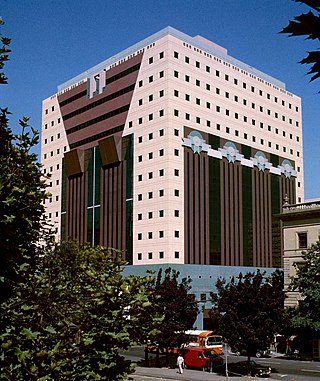
The Portland Building, alternatively referenced as the Portland Municipal Services Building, is a 15-story municipal office building located at 1120 SW 5th Avenue in downtown Portland, Oregon. Built at a cost of US$29 million, it opened in 1982 and was considered architecturally groundbreaking at the time.

The Lloyd's building is the home of the insurance institution Lloyd's of London. It is located on the former site of East India House in Lime Street, in London's main financial district, the City of London. The building is a leading example of radical Bowellism architecture in which the services for the building, such as ducts and lifts, are located on the exterior to maximise space in the interior.

Postmodern architecture is a style or movement which emerged in the 1960s as a reaction against the austerity, formality, and lack of variety of modern architecture, particularly in the international style advocated by Philip Johnson and Henry-Russell Hitchcock. The movement was formally introduced by the architect and urban planner Denise Scott Brown and architectural theorist Robert Venturi in their 1972 book Learning from Las Vegas. The style flourished from the 1980s through the 1990s, particularly in the work of Scott Brown & Venturi, Philip Johnson, Charles Moore and Michael Graves. In the late 1990s, it divided into a multitude of new tendencies, including high-tech architecture, neo-futurism, new classical architecture, and deconstructivism. However, some buildings built after this period are still considered postmodern.

The Renaissance Center, commonly known as the RenCen, is a complex of seven connected skyscrapers in downtown Detroit, Michigan, United States. Located on the Detroit International Riverfront, the RenCen is owned and used by General Motors as its world headquarters. The complex includes a 73-story Marriott hotel at its center, surrounded by four 39-story office towers, connected by a large square podium containing public spaces, a conference center, retail stores, restaurants, and a company showroom.

122 Leadenhall Street, which is also known as the Leadenhall Building, is a 225-metre-tall (738 ft) skyscraper in central London. It opened in July 2014 and was designed by the Rogers Stirk Harbour + Partners; it is known informally as The Cheesegrater because of its distinctive wedge shape, similar to that of the kitchen utensil of the same name. It is one of numerous tall buildings recently completed or under construction in the City of London financial district, including 20 Fenchurch Street, 22 Bishopsgate and The Scalpel.
Marco Polo was a 13th-century Italian explorer.
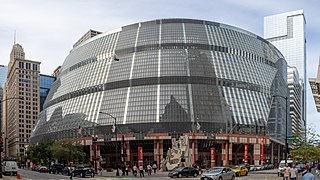
The James R. Thompson Center (JRTC), under reconstruction as Google Center or Googleplex Chicago and originally the State of Illinois Center, is a postmodern-style building designed by architect Helmut Jahn, located at 100 W. Randolph Street in the Loop district of Chicago. Designed around a post-modernist rotunda, it was built to house offices of the Illinois state government in the most populated city and county of the state and opened in 1985. In 2022, state government offices were relocated nearby to less costly quarters. Internet company Google purchased the building from the state and expects to move in 2026, after two years and $280 million of renovations.
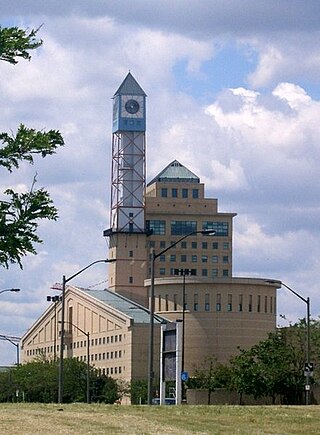
The Mississauga Civic Centre is the seat of local government of Mississauga, Ontario, Canada. The 37,280 square metre complex is a prominent example of postmodern architecture in Canada, finished in 1987 by Jones and Kirkland. It stands at 92 metres or 302 feet. The design was influenced by farmsteads which once occupied much of Mississauga as well as historical features of city centres. The building, for instance, includes a prominent clock tower. It was chosen as the winner of a design competition that included 246 submissions. Mississauga Civic Centre is located in the City Centre near Square One Shopping Centre and is home to the Mississauga City Council. The civic center building is considered one of the most iconic and recognizable buildings and cultural icons of Mississauga city.
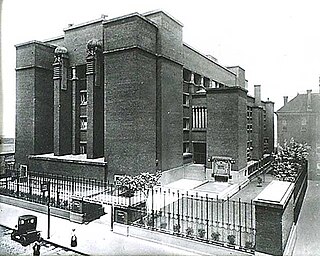
The Larkin Building was an office building in Buffalo, New York, noted for innovations that included central air conditioning, built-in desk furniture, and suspended toilet partitions and bowls. Located at 680 Seneca Street, it was demolished in 1950.

QVC UK is a television shopping channel broadcast from the United Kingdom to the United Kingdom and Ireland. It was formed in 1993 when QVC, Inc. agreed to a deal with Sky TV to create a UK version of the US channel. "QVC – The Shopping Channel" first broadcast in the UK on 1 October 1993.

Now was a British television channel transmitted as part of the British Satellite Broadcasting service during 1990.
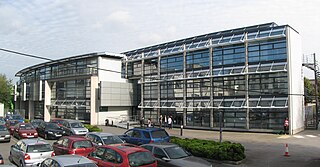
The Centenary Building is a building at the University of Salford in Greater Manchester, England. It was designed by the architect Stephen Hodder, completed in December 1995, and opened in 1996. The building won the RIBA Award and inaugural Stirling Prize in 1996, as well as the Civic Trust Award in 1998.

The Europa building is the seat of the European Council and Council of the European Union, located on the Rue de la Loi/Wetstraat in the European Quarter of Brussels, Belgium. Its defining feature is the multi-storey "lantern-shaped" construct holding the main meeting rooms; a representation of which has been adopted by both the European Council and Council of the EU as their official emblems.
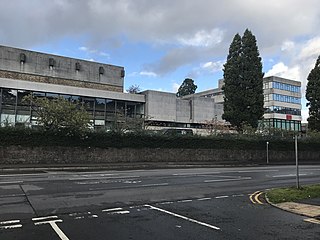
Broadcasting House was the headquarters of BBC Cymru Wales' radio, television and online services, situated in north Cardiff. The purpose-built facility opened in 1966 and consisted of three blocks containing studios, offices and technical facilities. In 2020 the BBC moved out, transferring to New Broadcasting House in Central Square, Cardiff. The building was demolished between 2021 and 2022, with the site to be used for new housing.

The Twentieth Century Society, founded in 1979 as The Thirties Society, is a British charity that campaigns for the preservation of architectural heritage from 1914 onwards. It is formally recognised as one of the National Amenity Societies, and as such is a statutory consultee on alterations to listed buildings within its period of interest.

Metropolis Studios is a music production and entertainment industry company established in 1989 by Gary Langan, Carey Taylor, Karin Clayton and Alexander Skeaping. It is located in the Power House, a Grade II listed building, at 70 Chiswick High Road in Chiswick, London, England. Over the last twenty years the group has expanded and now consists of three divisions: Metropolis Studios, Metropolis Mastering, and Digital Media/Productions.
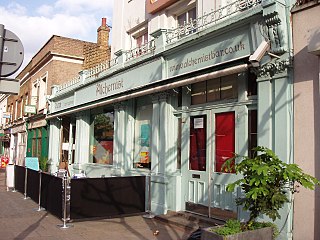
The Alchemist is a former pub at 225 St John's Hill, Battersea, London, that was controversially demolished in May 2015 after over 100 years in business, and rebuilt in 2018.
